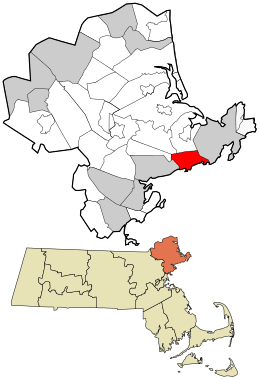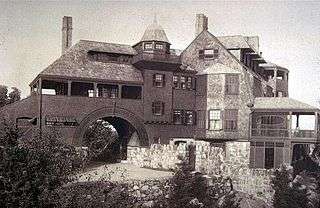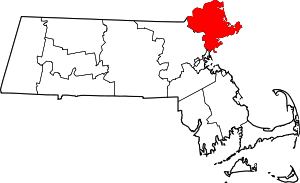Manchester-by-the-Sea, Massachusetts
Manchester-by-the-Sea (also known simply as Manchester) is a town on Cape Ann, in Essex County, Massachusetts, United States. The town is known for scenic beaches and vista points. At the 2010 census, the population was 5,136.[1]
Manchester-by-the-Sea, Massachusetts | |
|---|---|
The First Parish Church in central Manchester-by-the-Sea | |
 Seal | |
 Location in Essex County and the state of Massachusetts. | |
| Coordinates: 42°34′40″N 70°46′10″W | |
| Country | United States |
| State | Massachusetts |
| County | Essex |
| Settled | 1629 |
| Incorporated | 1645 |
| Government | |
| • Type | Open town meeting |
| Area | |
| • Total | 18.3 sq mi (47.3 km2) |
| • Land | 9.2 sq mi (23.9 km2) |
| • Water | 9.0 sq mi (23.4 km2) |
| Elevation | 30 ft (9 m) |
| Population (2010) | |
| • Total | 5,136 |
| • Density | 280/sq mi (110/km2) |
| Time zone | UTC-5 (Eastern) |
| • Summer (DST) | UTC-4 (Eastern) |
| ZIP code | 01944 |
| Area code(s) | 351 / 978 |
| FIPS code | 25-37995 |
| GNIS feature ID | 0619451 |
| Website | www |
History

Manchester was first settled by English colonists in 1629 and was officially incorporated in 1645. It was formed from territory taken from Salem (that portion since given to Beverly) and Gloucester.
The community thrived primarily as a fishing community for more than 200 years. Beginning in 1845, it started to attract summer residents from the Boston area after poet Richard Dana built a house in the town. Over the next fifty years, development of summer houses along the coastline established the community as Boston society's community of choice for summer residency. The trend continued with designs of houses by architects, such as "Sunny Waters", designed by John Hubbard Sturgis for his older brother, Russell, in 1862.
The best known of these "summer cottages" was Kragsyde, built on Smith's Point in 1883. Commissioned by George Nixon Black, the Peabody and Stearns-designed residence has been hailed as the zenith of the Shingle style substyle of the Queen Anne style of architecture. It was demolished in 1929.
Name
To prevent confusion with the nearby and much larger city of Manchester, New Hampshire, the name of the town was officially changed in 1989 following a close town meeting vote that year. This was ratified by an act of the state legislature passed on September 25, 1989.[2]
The name change was driven by Edward Corley, a longtime resident of Manchester.[3] All town documents, and the town seal, now use the name "Manchester-by-the-Sea". As a result of some minor resident activism, so do the majority of public and private lists of Massachusetts cities and towns, including that of the state government.
Geography
According to the United States Census Bureau, the town has a total area of 18.3 square miles (47.3 km2), of which 9.2 square miles (23.9 km2) is land and 9.0 square miles (23.4 km2), or 49.47%, is water. The town lies along the North Shore of Massachusetts Bay, which in turn leads to the Atlantic Ocean. There are seven beaches lining the coast, and several small islands dot the coast, the largest being Kettle Island and House Island.
Several small coves edge the coast, the largest being Manchester Harbor, which is fed by Sawmill Brook and other small bodies of water. There are several protected areas within town, including Cedar Swamp Conservation Area, Cheever Commons Conservation Area, Coolidge Reservation, Dexter Pond, Owl's Nest Nature Preservation Land, Powder House Hill Reservation, and Wyman Hill Conservation Area.
Manchester-by-the-Sea is bordered by Beverly and Wenham to the west, Hamilton to the northwest, Essex to the north, and Gloucester to the east. The town is located 9 miles (14 km) northeast of Salem and 24 miles (39 km) northeast of Boston.
Transportation
Manchester-by-the-Sea lies along Massachusetts Route 128, the inner of two beltways around Greater Boston. Route 128 has two exits within town as it passes from Beverly to Gloucester, with a small portion crossing through the corner of Essex. Route 127 also passes from west to east through town, traveling through the center of town. There is no bus service directly into town, with service passing east via the Cape Ann Transportation Authority in Gloucester, and an MBTA bus route providing service to Beverly.
The town is served by a stop along the Newburyport/Rockport Line of the MBTA Commuter Rail, providing service from Rockport along the North Shore to Boston's North Station. The nearest airport is the Beverly Municipal Airport, with the nearest national and international service at Boston's Logan International Airport.
Demographics
| Year | Pop. | ±% |
|---|---|---|
| 1850 | 1,638 | — |
| 1860 | 1,698 | +3.7% |
| 1870 | 1,665 | −1.9% |
| 1880 | 1,640 | −1.5% |
| 1890 | 1,789 | +9.1% |
| 1900 | 2,522 | +41.0% |
| 1910 | 2,673 | +6.0% |
| 1920 | 2,466 | −7.7% |
| 1930 | 2,636 | +6.9% |
| 1940 | 2,472 | −6.2% |
| 1950 | 2,868 | +16.0% |
| 1960 | 3,932 | +37.1% |
| 1970 | 5,151 | +31.0% |
| 1980 | 5,424 | +5.3% |
| 1990 | 5,286 | −2.5% |
| 2000 | 5,228 | −1.1% |
| 2010 | 5,136 | −1.8% |
| * = population estimate. Source: United States Census records and Population Estimates Program data.[4][5][6][7][8][9][10][11][12][13] | ||
As of the census of 2010,[14] there were 5,136 people, 2,147 households, and 1,444 families residing in the town. The population density was 562.7 people per square mile (217.3/km2). The racial makeup of the town was 97.6% (5,012) White, 0.1% (5) African American, 0.2% (10) Native American, 0.9% (46) Asian, 0.1% from other races, and 1.1% from two or more races. Hispanic or Latino of any race were 1.5% (77) of the population. The median income for a household in the town was $95,243, and the median income for a family was $109,760. About 4.5% of families and 5.1% of the population were below the poverty line, including 3.9% of those under age 18 and 3.7% of those age 65 or over.[14]
Newspaper
The local newspaper, The Manchester Cricket, is published weekly. Within the Cricket, there is a special section dedicated to the neighboring town, Essex. This section is called The Essex Echo. The town is also served by a regional newspaper, the Gloucester Daily Times.
Points of interest
Singing Beach
One mile from the town center is Singing Beach, so named because the sand comprising the beach squeaks when walked upon. The sand is an iridescent color when the sun sets.[15] This beach is quite popular during summer months in particular, because it is easily accessible from Boston by a half-mile walk from the MBTA train station. Also located on this historic beach is the famous tourist attraction "Eaglehead", a rock composite that is the focal point of rock climbing and other recreation activities.
Other points of interest
- Agassiz Rock
- Masconomo Park
- Coolidge Reservation
- Crow Island
- Kragsyde
- Smith's Point
- Manchester Historical Museum (Trask House)
- Tucks Point
- Cathedral Pines[16]
 Kragsyde Mansion (1885, demolished 1929)
Kragsyde Mansion (1885, demolished 1929)- Town Hall
 Old Burial Ground
Old Burial Ground
Film and television references
The town provided the backdrop for these films:
- Tell Me That You Love Me, Junie Moon (1970)
- Mermaids (1990)
- The Good Son (1993)
- The Love Letter (1999)
- State and Main (2000)
- What's the Worst That Could Happen? (2001; standing in for Marblehead, Massachusetts)
- The Proposal (2009; standing in for Sitka, Alaska)
- Edge of Darkness (2010)
- Joy (2015)
- Manchester by the Sea (2016)
- Daddy's Home 2 (2017)
It was also featured in a season of the TV series This Old House, and was featured in a "Main Streets and Back Roads" episode of Chronicle, a newsmagazine program in New England.
Notable people
- Junius Brutus Booth, Jr., brother of John Wilkes Booth, Abraham Lincoln's assassin. Died September 17, 1883. Buried in Manchester.
- Nat Faxon, comedian and Oscar winner for adapted screenplay for The Descendants at the 84th Academy Awards
- Josh Gates, host of Destination Truth—former resident
- Rufus Gifford, United States ambassador to the Kingdom of Denmark from 2013-2017
- Elizabeth Porter Gould, poet and author
- Sprague Grayden, actress
- Henry Northey Hooper, manufacturer and Boston politician
- William Northey Hooper, a founder of the sugar industry in Hawaii
- Joe Lloyd, professional golfer
- James McMillan, Michigan senator instrumental in the design of the Washington Mall, died (1902) at his summer home in Manchester
- Susan Minot, author
- Ray Ozzie, software entrepreneur
- George Putnam III, trustee of Putnam Investments
- Gardner Read, composer
- David I. Robinson, politician
- Jay Severin, radio talk show host
- Josiah Spaulding, businessman, attorney, and politician; chairman of the Massachusetts Republican Party from 1965-1970
References
- "Profile of General Population and Housing Characteristics: 2010 Demographic Profile Data (DP-1): Manchester-by-the-Sea town, Essex County, Massachusetts". United States Census Bureau. Retrieved September 4, 2012.
- Manchester-by-the-Sea official website; accessed August 10, 2015.
- "Edward F. Corley, 68, Leader in Manchester-by-the-Sea". The Boston Globe, January 13, 1991. Archived by HighBeam Research. Retrieved February 28, 2017.
- "Total Population (P1), 2010 Census Summary File 1". American FactFinder, All County Subdivisions within Massachusetts. United States Census Bureau. 2010.
- "Massachusetts by Place and County Subdivision - GCT-T1. Population Estimates". United States Census Bureau. Retrieved July 12, 2011.
- "1990 Census of Population, General Population Characteristics: Massachusetts" (PDF). US Census Bureau. December 1990. Table 76: General Characteristics of Persons, Households, and Families: 1990. 1990 CP-1-23. Retrieved July 12, 2011.
- "1980 Census of the Population, Number of Inhabitants: Massachusetts" (PDF). US Census Bureau. December 1981. Table 4. Populations of County Subdivisions: 1960 to 1980. PC80-1-A23. Retrieved July 12, 2011.
- "1950 Census of Population" (PDF). Bureau of the Census. 1952. Section 6, Pages 21-10 and 21-11, Massachusetts Table 6. Population of Counties by Minor Civil Divisions: 1930 to 1950. Retrieved July 12, 2011.
- "1920 Census of Population" (PDF). Bureau of the Census. Number of Inhabitants, by Counties and Minor Civil Divisions. Pages 21-5 through 21-7. Massachusetts Table 2. Population of Counties by Minor Civil Divisions: 1920, 1910, and 1920. Retrieved July 12, 2011.
- "1890 Census of the Population" (PDF). Department of the Interior, Census Office. Pages 179 through 182. Massachusetts Table 5. Population of States and Territories by Minor Civil Divisions: 1880 and 1890. Retrieved July 12, 2011.
- "1870 Census of the Population" (PDF). Department of the Interior, Census Office. 1872. Pages 217 through 220. Table IX. Population of Minor Civil Divisions, &c. Massachusetts. Retrieved July 12, 2011.
- "1860 Census" (PDF). Department of the Interior, Census Office. 1864. Pages 220 through 226. State of Massachusetts Table No. 3. Populations of Cities, Towns, &c. Retrieved July 12, 2011.
- "1850 Census" (PDF). Department of the Interior, Census Office. 1854. Pages 338 through 393. Populations of Cities, Towns, &c. Retrieved July 12, 2011.
- "U.S. Census website". United States Census Bureau. Retrieved 14 January 2014.
- "Singing Beach". Manchester-by-the-Sea, MA.
- "Kiosk Completed at Wilderness Conservation Area Gateway". www.mect.org. Archived from the original on 2016-04-25. Retrieved 2016-04-28.
External links
| Wikimedia Commons has media related to Manchester-by-the-Sea, Massachusetts. |
| Wikisource has the text of a 1911 Encyclopædia Britannica article about Manchester-by-the-Sea, Massachusetts. |
